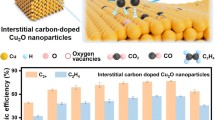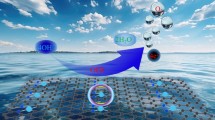Abstract
Ammonia is a potential fuel for producing and storing hydrogen, but its usage is constrained by the high cost of the noble metal catalysts to decompose NH3. Utilizing non-precious catalysts to decompose ammonia increases its potential for hydrogen production. In this study, carborundum (SiC)-supported cobalt catalysts were prepared by impregnating Co3O4 nanoparticles (NPs) on SiC support. The catalysts were characterized by high-resolution transmission electron microscope, X-ray photoelectron spectroscopy, temperature programmed reduction, etc. The results show that the large specific surface area of SiC can introduce highly distributed Co3O4 NPs onto the surface. The amount of Co in the catalysts has a significant effect on the catalyst structure, particle size and catalytic performances. Due to the interaction of cobalt species with SiC, the 25Co/SiC catalyst provided the optimal ammonia conversion of 73.2% with a space velocity of 30,000 mL gcat−1 h−1 at 550 °C, corresponding to the hydrogen production rate of 24.6 mmol H2 gcat−1 min−1. This research presents an opportunity to develop highly active and cost-effective catalysts for hydrogen production via NH3 decomposition.
Graphical abstract










Similar content being viewed by others
Data availability
The datasets generated during and/or analysed during the current study are available from the corresponding author on reasonable request.
References
Wang J, Qin Q, Li F et al (2022) Recent advances of MXenes Mo2C-based materials for efficient photocatalytic hydrogen evolution reaction. Carbon Lett. https://doi.org/10.1007/s42823-022-00401-2
Erken E, Yıldız Y, Kilbaş B et al (2016) Synthesis and characterization of nearly monodisperse pt nanoparticles for C1 to C3 alcohol oxidation and dehydrogenation of dimethylamine-borane (DMAB). J Nanosci Nanotechnol 16:5944–5950. https://doi.org/10.1166/jnn.2016.11683
Karaman C (2022) Engineering of N, P, S-Triple doped 3-dimensional graphene architecture: Catalyst-support for “surface-clean” Pd nanoparticles to boost the electrocatalysis of ethanol oxidation reaction. Int J Hydrogen Energy. https://doi.org/10.1016/j.ijhydene.2022.02.093
Jafarzadeh H, Karaman C, Güngör A et al (2022) Hydrogen production via sodium borohydride hydrolysis catalyzed by cobalt ferrite anchored nitrogen-and sulfur co-doped graphene hybrid nanocatalyst: artificial neural network modeling approach. Chem Eng Res Des 183:557–566. https://doi.org/10.1016/j.cherd.2022.05.038
Karaman C, Karaman O, Atar N et al (2021) Tailoring of cobalt phosphide anchored nitrogen and sulfur co-doped three dimensional graphene hybrid: Boosted electrocatalytic performance towards hydrogen evolution reaction. Electrochim Acta 380:138262. https://doi.org/10.1016/j.electacta.2021.138262
Karaman O (2022) Three-dimensional graphene network supported nickel-cobalt bimetallic alloy nanocatalyst for hydrogen production by hydrolysis of sodium borohydride and develo** of an artificial neural network modeling to forecast hydrogen production rate. Chem Eng Res Des 181:321–330. https://doi.org/10.1016/j.cherd.2022.03.028
Şen B, Aygün A, Şavk A et al (2018) Bimetallic palladium–iridium alloy nanoparticles as highly efficient and stable catalyst for the hydrogen evolution reaction. Int J Hydrogen Energy 43:20183–20191. https://doi.org/10.1016/j.ijhydene.2018.07.081
Şen B, Aygün A, Okyay TO et al (2018) Monodisperse palladium nanoparticles assembled on graphene oxide with the high catalytic activity and reusability in the dehydrogenation of dimethylamine-borane. Int J Hydrogen Energy 43:20176–20182. https://doi.org/10.1016/j.ijhydene.2018.03.175
Ratnakar RR, Gupta N, Zhang K et al (2021) Hydrogen supply chain and challenges in large-scale LH2 storage and transportation. Int J Hydrogen Energy 46:24149–24168. https://doi.org/10.1016/j.ijhydene.2021.05.025
Sun S, Jiang Q, Zhao D et al (2022) Ammonia as hydrogen carrier: advances in ammonia decomposition catalysts for promising hydrogen production. Renew Sustain Energy Rev 169:112918. https://doi.org/10.1016/j.rser.2022.112918
Akça A, Küçük H, Karaman O et al (2021) Theoretical insights into the NH3 decomposition mechanism on the Cu- and Pt- embedded graphene surfaces: a DFT approach. ECS J Solid State Sci Technol. 10:101008. https://doi.org/10.1149/2162-8777/ac2d51
Mukherjee S, Devaguptapu SV, Sviripa A et al (2018) Low-temperature ammonia decomposition catalysts for hydrogen generation. Appl Catal B 226:162–181. https://doi.org/10.1016/j.apcatb.2017.12.039
**e P, Yao Y, Huang Z et al (2019) Highly efficient decomposition of ammonia using high-entropy alloy catalysts. Nat Commun 10:4011. https://doi.org/10.1038/s41467-019-11848-9
Srifa A, Okura K, Okanishi T et al (2017) Hydrogen production by ammonia decomposition over Cs-modified Co3Mo3N catalysts. Appl Catal B 218:1–8. https://doi.org/10.1016/j.apcatb.2017.06.034
Zhou C, Wu K, Huang H et al (2021) Spatial confinement of electron-rich Ni Nanoparticles for efficient ammonia decomposition to hydrogen production. ACS Catal 11:10345–10350. https://doi.org/10.1021/acscatal.1c02420
Gu Y, Ma Y, Long Z et al (2021) One-pot synthesis of supported Ni@Al2O3 catalysts with uniform small-sized Ni for hydrogen generation via ammonia decomposition. Int J Hydrogen Energy 46:4045–4054. https://doi.org/10.1016/j.ijhydene.2020.11.003
Li XK, Ji WJ, Zhao J et al (2005) Ammonia decomposition over Ru and Ni catalysts supported on fumed SiO2, MCM-41, and SBA-15. J Catal 236:181–189. https://doi.org/10.1016/j.jcat.2005.09.030
Lucentini I, Serrano I, Soler L et al (2020) Ammonia decomposition over 3D-printed CeO2 structures loaded with Ni. Appl. Catal A General 591:117382. https://doi.org/10.1016/j.apcata.2019.117382
Bell TE, Ménard H, González Carballo JM et al (2020) Hydrogen production from ammonia decomposition using Co/γ-Al2O3 catalysts – Insights into the effect of synthetic method. Int J Hydrogen Energy 45:27210–27220. https://doi.org/10.1016/j.ijhydene.2020.07.090
Huang C, Yu Y, Tang X et al (2020) Hydrogen generation by ammonia decomposition over Co/CeO2 catalyst: influence of support morphologies. Appl Surf Sci 532:147335. https://doi.org/10.1016/j.apsusc.2020.147335
Pinzón M, Romero A, de Lucas CA et al (2021) Hydrogen production by ammonia decomposition over ruthenium supported on SiC catalyst. J Ind Eng Chem 94:326–335. https://doi.org/10.1016/j.jiec.2020.11.003
Zhang Y, Song Z, Yan Y et al (2018) Performance of Fe/SiC catalysts for cracking of toluene under microwave irradiation. Int J Hydrogen Energy 43:7227–7236. https://doi.org/10.1016/j.ijhydene.2018.02.158
Guo XY, ** GQ, Wang YY (2010) Preparations and catalytic applications of high surface area silicon carbide. Acta Phys Chim Sin 26:1143–1150. https://doi.org/10.3866/PKU.WHXB20100426
Li T, Xu L, Wang L et al (2009) Synthesis and characterization of 3C and 2H-SiC nanocrystals starting from SiO2, C2H5OH and metallic Mg. J Alloy Compd 484:341–346. https://doi.org/10.1016/j.jallcom.2009.04.096
Bathula C, Rabani I, Ramesh S et al (2021) Highly efficient solid-state synthesis of Co3O4 on multiwalled carbon nanotubes for supercapacitors. J Alloy Compd 887:161307. https://doi.org/10.1016/j.jallcom.2021.161307
Wieligor M, Wang Y, Zerda TW (2005) Raman spectra of silicon carbide small particles and nanowires. J Phys: Condens Matter 17:2387. https://doi.org/10.1088/0953-8984/17/15/010
Lee CP, Murti BT, Yang PK et al (2021) Cobalt oxide-decorated silicon carbide nano-tree array electrode for micro-supercapacitor application. Materials. https://doi.org/10.3390/ma14164514
Ding C, Kang S, Li W et al (2022) Mesoporous structure and amorphous Fe-N sites regulation in Fe-g-C3N4 for boosted visible-light-driven photo-Fenton reaction. J Colloid Interface Sci 608:2515–2528. https://doi.org/10.1016/j.jcis.2021.10.168
Wang J, Wang Y, Tong X et al (2020) Highly active Ir/SiC catalyst for aqueous hydrogenation of levulinic acid to γ-valerolactone. Catal Commun 139:105971. https://doi.org/10.1016/j.catcom.2020.105971
Wu Y, Zhao Y, Zhai P et al (2022) Triggering lattice oxygen activation of single-atomic mo sites anchored on Ni-Fe oxyhydroxides nanoarrays for electrochemical water oxidation. Adv Mater 34:2202523. https://doi.org/10.1002/adma.202202523
**ao L, Bao W, Zhang J et al (2022) Interfacial interaction between NiMoP and NiFe-LDH to regulate the electronic structure toward high-efficiency electrocatalytic oxygen evolution reaction. Int J Hydrogen Energy 47:9230–9238. https://doi.org/10.1016/j.ijhydene.2021.12.258
**ao R, Luo D, Wang J et al (2022) Oxidation states regulation of cobalt active sites through crystal surface engineering for enhanced polysulfide conversion in lithium-sulfur batteries. Adv Sci 9:2202352. https://doi.org/10.1002/advs.202202352
Liu G, Wang H, Deplazes S et al (2021) Ba-Al-decorated iron ore as bifunctional oxygen carrier and HCl sorbent for chemical loo** combustion of syngas. Combust Flame 223:230–242. https://doi.org/10.1016/j.combustflame.2020.09.021
Zeng S, Zhang L, Zhang X et al (2012) Modification effect of natural mixed rare earths on Co/γ-Al2O3 catalysts for CH4/CO2 reforming to synthesis gas. Int J Hydrogen Energy 37:9994–10001. https://doi.org/10.1016/j.ijhydene.2012.04.014
Guo X, Li Y, Shi R et al (2009) Co/MgO catalysts for hydrogenolysis of glycerol to 1,2-propanediol. Appl Catal A 371:108–113. https://doi.org/10.1016/j.apcata.2009.09.037
Takanabe K, Nagaoka K, Nariai K et al (2005) Influence of reduction temperature on the catalytic behavior of Co/TiO2 catalysts for CH4/CO2 reforming and its relation with titania bulk crystal structure. J Catal 230:75–85. https://doi.org/10.1016/j.jcat.2004.11.005
Yu P, Wu H, Guo J et al (2020) Effect of BaNH, CaNH, Mg3N2 on the activity of Co in NH3 decomposition catalysis. J Energy Chem 46:16–21. https://doi.org/10.1016/j.jechem.2019.10.014
Al-attar OA, Podila S, Al-Zahrani AA (2022) Preparation and study of XCeO3 (X: Mg, Ca, Sr, Ba) type oxide supported cobalt catalyst for hydrogen production by ammonia decomposition. Arab J Sci Eng. https://doi.org/10.1007/s13369-022-07255-w
Lara-García HA, Mendoza-Nieto JA, Pfeiffer H et al (2019) COx-free hydrogen production from ammonia on novel cobalt catalysts supported on 1D titanate nanotubes. Int J Hydrogen Energy 44:30062–30074. https://doi.org/10.1016/j.ijhydene.2019.09.120
Gu Y, Xu D, Huang Y et al (2021) COx-free hydrogen production via ammonia decomposition over mesoporous Co/Al2O3 catalysts with highly dispersed co species synthesized by a facile method. Dalton Trans 50:1443–1452. https://doi.org/10.1039/D0DT03262J
Wu ZW, Li X, Qin YH et al (2020) Ammonia decomposition over SiO2-supported Ni-Co bimetallic catalyst for COx-free hydrogen generation. Int J Hydrogen Energy 45:15263–15269. https://doi.org/10.1016/j.ijhydene.2020.04.007
Li H, Guo L, Qu J et al (2022) Co-Ni supported yttrium oxide material as a catalyst for ammonia decomposition to COx-free hydrogen. Int J Hydrogen Energy. https://doi.org/10.1016/j.ijhydene.2022.11.338
He H, Jiang H, Yang F et al (2022) Bimetallic NixCo10-x/CeO2 as highly active catalysts to enhance mid-temperature ammonia decomposition: kinetics and synergies. Int J Hydrogen Energy. https://doi.org/10.1016/j.ijhydene.2022.10.255
Yin SF, Xu BQ, Zhou XP et al (2004) A mini-review on ammonia decomposition catalysts for on-site generation of hydrogen for fuel cell applications. Appl Catal A 277:1–9. https://doi.org/10.1016/j.apcata.2004.09.020
Acknowledgements
This work is supported by the National Natural Science Foundation of China (21878001, 22078002 and 22078027) and International Joint Lab of Jiangsu Education Department. Special thanks to the support from Advanced Catalysis and Green Manufacturing Collaborative Innovation Center, Changzhou University (ACGM2016-06-02 and ACGM2016-06-03), Projects Funded by the Priority Academic Program Development of Jiangsu Higher Education Institutions (PAPD) and Postgraduate Research & Practice Innovation Program of Jiangsu Province.
Funding
National Natural Science Foundation of China, 21878001, Zhi** Lei, 22078002, Zhi** Lei, 22078027, Fengxiang Yin.
Author information
Authors and Affiliations
Corresponding authors
Ethics declarations
Conflict of interest
There are no conflicts to declare.
Additional information
Publisher's Note
Springer Nature remains neutral with regard to jurisdictional claims in published maps and institutional affiliations.
Supplementary Information
Below is the link to the electronic supplementary material.
Rights and permissions
Springer Nature or its licensor (e.g. a society or other partner) holds exclusive rights to this article under a publishing agreement with the author(s) or other rightsholder(s); author self-archiving of the accepted manuscript version of this article is solely governed by the terms of such publishing agreement and applicable law.
About this article
Cite this article
Li, G., Tan, Y., Lei, Z. et al. Preparation of high surface area carborundum-supported cobalt catalysts for hydrogen production by ammonia decomposition. Carbon Lett. 33, 899–908 (2023). https://doi.org/10.1007/s42823-023-00471-w
Received:
Revised:
Accepted:
Published:
Issue Date:
DOI: https://doi.org/10.1007/s42823-023-00471-w




